



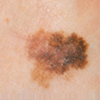
If the spot or lesion is divided in half, the two halves are not a mirror image.
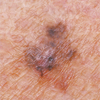
A spot or lesion with a spreading or irregular edge.
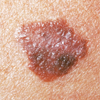
A spot or lesion with a number of different colours through it.
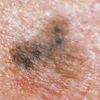
The spot or lesion is usually greater than 6mm across. However, suspect lesions of smaller diameter should also be investigated.

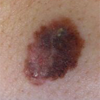
A spot or lesion that changes over time (size, shape, symptoms, surface, colour).

Amelanotic melanoma is a type of skin cancer in which the cells do not make melanin. It can be pink, red, purple or of normal skin colour and hence difficult to recognise. It usually has an asymmetrical shape, and an irregular faintly pigmented border. As the atypical appearance can lead to a delay in diagnosis, there is as a result a poorer prognosis with a risk of recurrence.

Nodular melanoma is the most aggressive form of melanoma. It tends to grow more rapidly in thickness than in diameter. Nodular melanomas are typically characterised by a raised, nodular lesion with irregular patches of colour and an irregular border. Up to 20% of these nodular melanomas may not have any pigment and this can make diagnosis more difficult. An ulcerated and / or bleeding lesion is common.
Melanoma accounts for 1-2% of skin cancers. It is the most dangerous and aggressive form of skin cancer. If left untreated it can spread to other parts of the body and can be fatal.
Melanoma usually grows quickly over weeks to months. It can appear as a new or existing spot, freckle or mole that changes in colour, size or shape. It can grow anywhere on the body, not just areas exposed to the sun, and occurs most frequently on the upper back in males and on the lower leg in females.
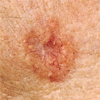
BCC accounts for about two thirds of skin cancers and grows slowly over months or years.
Look for small, round or flattened spots that are red, pale or pearly in colour. Some are scaly like a patch of eczema, or may become ulcerated, bleed and fail to heal. BCCs are usually found on the upper body, head or neck.
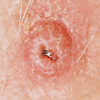
SCC accounts for about one third of skin cancers and grows over months and may spread if not treated.
Look for scaly red areas that may bleed easily, ulcers or non-healing sores that are often painful, especially when touched. SCCs are often found on lips, ears, scalp, the back of the hand and lower legs.

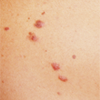
Dysplastic naevi are odd-shaped moles that may indicate a greater risk of developing melanoma. They are usually 5-10mm wide with uneven colouring.
If you have lots of odd-shaped moles get your skin checked regularly by your doctor.
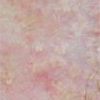
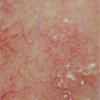
Solar keratoses are generally hard, red, scaly spots on sun-exposed areas of the skin. They are most commonly found on the head, neck and on the back of the hands.
Solar keratoses is a warning sign that the skin has been damaged by the sun and that skin cancers may develop. If you have solar keratoses, protect yourself from further sun damage and have your skin checked regularly by a doctor.
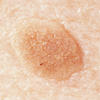
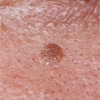
Seborrhoeic keratoses are common non-cancerous spots sometimes confused with melanomas. They are raised warty-looking brown or black lesions with well-defined borders, and are mostly found on the torso but can occur anywhere on the body.
With a bit of practice, most people can check their whole body in 15 minutes. You will need to undress completely and use a well-lit room. A squamous or basal cell carcinoma is likely to develop on skin most often exposed to the sun, but a melanoma can develop anywhere, so check your whole body.
Check your whole face including around the nose, lips and ears.
The scalp is difficult to examine alone. It’s best to ask a partner or friend for help. Make sure you part your hair. Try using a hand-held blow dryer or a comb to lift the hair from the scalp.
Use a hand-held mirror to check the back of your neck and ears. Ask a partner for help if you need to.
Look at the front and back of your torso. If possible, ask a partner to check your back. Raise your arms and look at your right and left side.
Examine the backs of your hands, fingers, spaces between the fingers and under fingernails. Turn your hands over so the palms face up. Look carefully.
Face the mirror and look at your forearms and upper arms. Bend elbows to look at the undersides.
With your back towards the full-length mirror, look at your buttocks. A hand-held mirror can really help here.
Sit down and check the front and back of your thighs and lower legs. Use a hand-held mirror.
While sitting, cross one leg over the other. Examine the top of your foot, the toes, toenails and spaces between the toes. Check the sole or bottom of your foot; you may prefer to use a hand-held mirror to do this. Repeat the step with your other foot.
Click the button below to check out newer, awesome options. Update my browser now